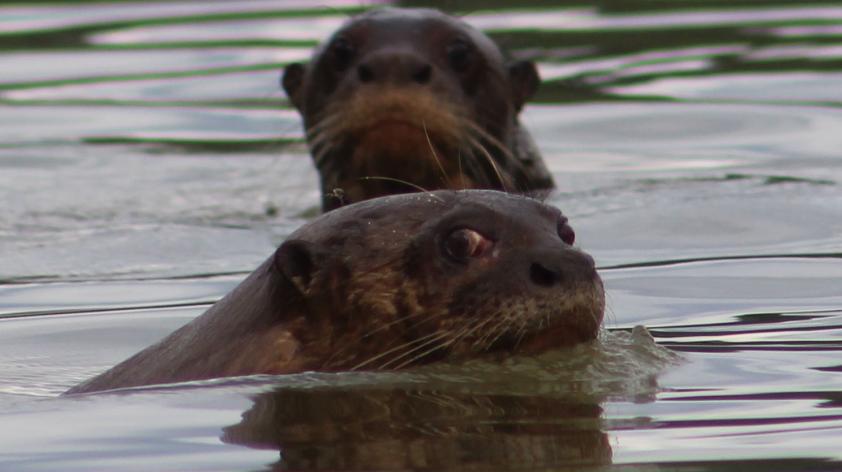
Looking for giant otters in mined areas of the Peruvian Amazon
It is early morning and the sun is rising over the lower Madre de Dios river. My Peruvian field assistants, Panchito and Juan, and I, step off our project boat, the Chavaropana (meaning ‘giant otter’ in the Matsigenka language), and pick up a good trail, passing through several gravel mounts and pools of murky, brownish water, evidence of recent gold mining activities. We are here to survey an oxbow lake, as part of a new giant otter project.
On a sandy patch by the trail, Panchito sees fresh otter tracks. We move on and approach the lake bank, by a small pool containing a ‘chupadera’, the local term for a heavy machine that pumps sediment and water from lake bottoms to obtain gold. We start inflating our black and red research kayak and enter the lake.
We set out to survey the lake banks and use our binoculars to search for more otter signs. I am new to this project, having recently joined the San Diego Zoo Institute for Conservation Research and the WildCRU unit at Oxford University. I do not know much about giant otters yet, but my intuition tells me that the chances of finding one in such a disturbed lake, with such proximity to human activity, are slim. It turns out I am wrong.
After 15 minutes of surveying the lake, Panchito, who always detects animals a few seconds before I do, whispers “lobo” (‘lobo de rio’ – river wolf - is the commonly used name for giant otters in this area). I look to the left, where Panchito is pointing, and see a giant otter swimming close to our kayak and inspecting the new intruders to the lake. The sighting lasts less than two minutes, as the otter passes us by, going about its business, and disappears in the swamp vegetation.
This disturbed oxbow lake is one out of seven where we detected giant otters in the heavy lower Madre de Dios mining zone. This solitary otter appears to be making a living in a lake where part of the banks have been destroyed and loud engine noises are frequently heard, and where water could be contaminated by mercury, a toxic byproduct of mining activity.
In lakes, solitary giant otters are not as commonly observed as family groups. Jessica Groenendijk, who is part of this project and has studied giant otters in the Peruvian Amazon for several years, has found that they are typically otters who left their natal group. Such individuals often try to establish new territories and found new family groups. They may have to settle for lower quality territories, since the good ones are already taken by groups. This could be the case here.
We will return to this lake in a few months, and hopefully on several occasions over the next five years. Now that we have established that giant otters can occupy lakes in heavily mined zones, we will monitor them, in an attempt to understand the influence of such human activities on their ability to find food, survive and reproduce. To understand how oxbow lake ecosystems are affected by mining activities, we also plan to sample fish in these lakes. Similar investigations in the protected, more pristine Manu National Park, will serve for comparison. Jessica and Recovery Ecology director Ron Swaisgood have recently joined me on a trip to examine oxbow lakes within the park and in its vicinity.
On our way out of the lake, we meet and chat with two miners, who have recently arrived to start their morning’s work with the chupadera. The miners tell us about a regional football tournament they took part in on the previous day. They ask about the purpose of our kayak and new boat, with which they are impressed. We answer that we are here for the otters, but do not mention mining activities.
We take the trail back to our boat and move on down the Madre de Dios river, through the heavily mined zone. We survey another lake, where we find giant otters again, a pair this time. This is the first detailed survey of this area since 2008, when only one group was found in these lakes. The finding that several giant otter groups persist here is encouraging, because it provides us with an opportunity to assess the effects of habitat destruction and water contamination on these large carnivores.













